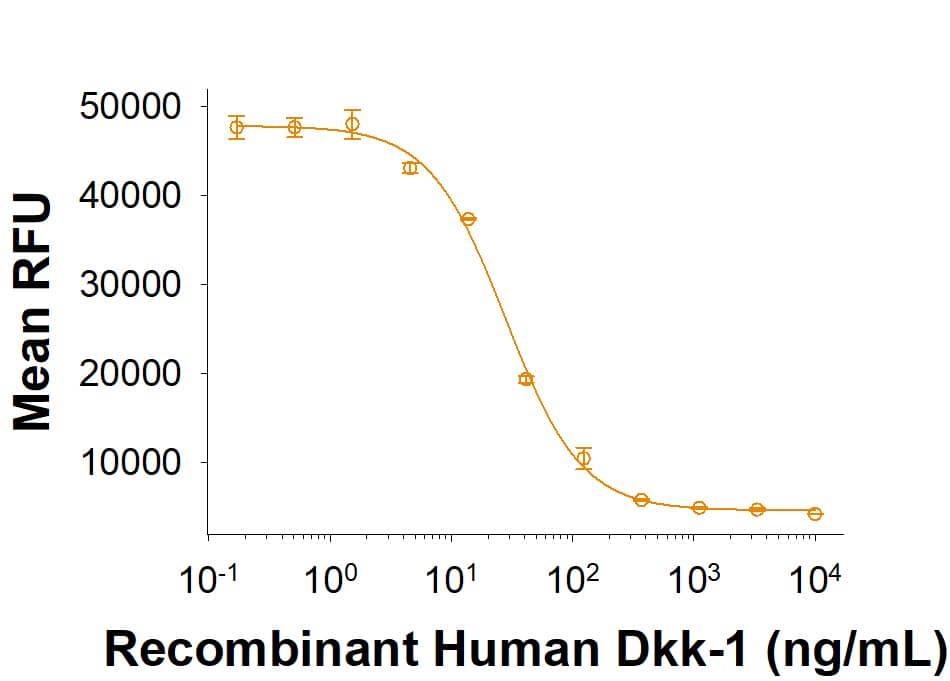Recombinant Human Dkk-1 Protein, CF
R&D Systems, part of Bio-Techne | Catalog # 11387-DK

Key Product Details
Product Specifications
Source
Thr32-His266
Purity
Endotoxin Level
N-terminal Sequence Analysis
Predicted Molecular Mass
SDS-PAGE
Activity
The ED50 for this effect is 8.00-96.0 ng/mL.
Scientific Data Images for Recombinant Human Dkk-1 Protein, CF
Recombinant Human Dkk‑1 Protein Bioactivity.
Recombinant Human Dkk-1 (Catalog # 11387-DK) inhibits Recombinant Mouse Wnt-3a (1324-WN) induced TCF reporter activity in HEK293 human embryonic kidney cells. The ED50 for this effect is 8.00-96.0 ng/mL.Recombinant Human Dkk‑1 Protein SDS-PAGE.
2 μg/lane of Recombinant Human Dkk‑1 Protein (Catalog # 11387-DK) was resolved with SDS-PAGE under reducing (R) and non-reducing (NR) conditions and visualized by Coomassie® Blue staining, showing bands at 38-42 kDa, under reducing conditions.Formulation, Preparation and Storage
11387-DK
| Formulation | Lyophilized from a 0.2 μm filtered solution in PBS with Trehalose. |
| Reconstitution | Reconstitute the 20 μg size at 200 μg/mL in PBS. Reconstitute all other sizes at 500 μg/mL in PBS. |
| Shipping | The product is shipped at ambient temperature. Upon receipt, store it immediately at the temperature recommended below. |
| Stability & Storage | Use a manual defrost freezer and avoid repeated freeze-thaw cycles.
|
Background: Dkk-1
Dickkopf related protein 1 (Dkk-1) is the founding member of the Dickkopf family of proteins that includes Dkk-1, -2, -3, -4, and a related protein, Soggy (1, 2). Dkk proteins are secreted proteins that contain two conserved cysteine-rich domains separated by a linker region. Each domain contains ten cysteine residues (1‑3). Mature human Dkk-1 is a 40 kDa glycosylated protein that shares 86%, 87%, 90% and 91% aa sequence identity with mouse, rat, rabbit and bovine Dkk-1, respectively. It also shares 42% and 36% aa identity with human Dkk-2 and Dkk-4, respectively. Dkk-1 and Dkk-4 are well documented antagonists of the canonical Wnt signaling pathway (1, 2). This pathway is activated by Wnt engagement of a receptor complex composed of the Frizzled proteins and one of two low-density lipoprotein receptor-related proteins, LRP5 or LRP6 (4). Dkk-1 antagonizes Wnt by forming ternary complexes of LRP5/6 with Kremen1 or Kremen2 (4, 5). Dkk-1/LRP6/Krm2 complex internalization has been shown to down-regulate Wnt signaling (4, 5). Dkk-1 is expressed throughout development and antagonizes Wnt-7a during limb development (6, 7). Other sites of expression include developing neurons, hair follicles and the retina of the eye (8, 9). The balance between Wnt signaling and Dkk-1 inhibition is critical for bone formation and homeostasis (10). Insufficient or excess Dkk-1 activity in bone results in increased or decreased bone density, respectively (8, 11). In adults, Dkk-1 is expressed in osteoblasts and osteocytes, and neurons. Cerebral ischemia induces Dkk-1 expression, which contributes to neuronal cell death (12).
References
- Krupnik, V.E. et al. (1999) Gene 238:301.
- Niehrs, C. (2006) Oncogene 25:7469.
- Bullock, C.M. et al. (2004) Mol. Pharmacol. 65:582.
- Mao, B. et al. (2001) Nature 411:321.
- Mao, B. et al. (2002) Nature 417:664.
- Kemp, C. et al. (2005) Dev. Dyn. 233:1064.
- Adamska, M. et al. (2004) Dev. Biol. 272:134.
- Li, J. et al. (2006) Bone 36:754.
- Verani, R. et al. (2006) J. Neurochem. 101:242.
- Pinzone, J.J. et al. (2009) Blood 113:517.
- Morvan, F. et al. (2006) J. Bone Miner. Res. 21:934.
- Cappuccio, I. et al. (2005) J. Neurosci. 25:2647.
Long Name
Alternate Names
Gene Symbol
UniProt
Additional Dkk-1 Products
Product Documents for Recombinant Human Dkk-1 Protein, CF
Product Specific Notices for Recombinant Human Dkk-1 Protein, CF
For research use only

